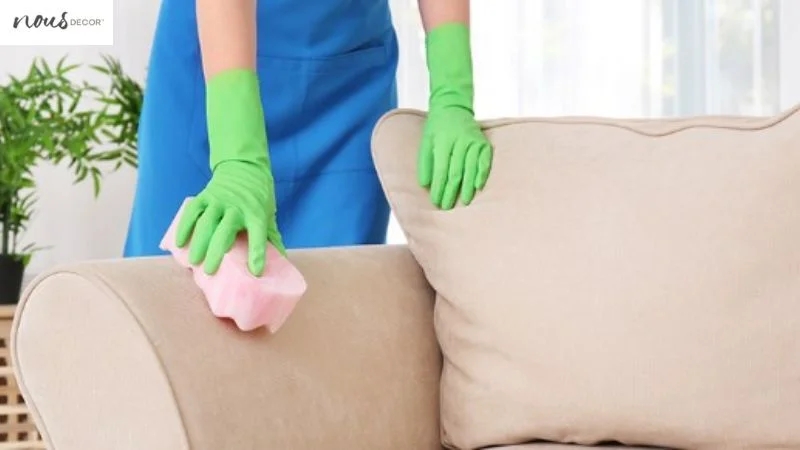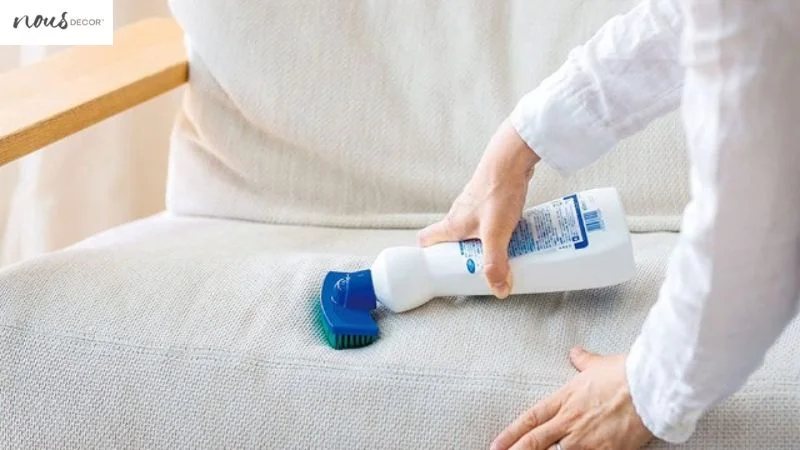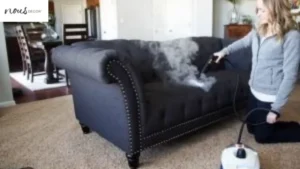Cleaning a polyester sofa doesn’t have to be an intimidating task. With the right supplies and a few simple steps, your sofa will look as good as new in no time.
From vacuuming to wiping, I’ll walk you through each step of the How To Clean Polyester Sofa process so you can ensure your sofa is properly cleaned and cared for. You’ll also learn tips and tricks on how to clean upholstery regularly so it looks its best all year round!
So grab your cleaning supplies and let’s get started with Nousdecor!
Key Takeaways of How To Clean Polyester Sofa
- Vacuum the entire surface of the sofa before cleaning to remove any loose dirt and debris.
- Always test any cleaning solution on a hidden area of the sofa to ensure it does not cause damage or discoloration.
- Use a soft cloth or upholstery attachment to apply the cleaning solution to spots and stains, and a spray bottle or upholstery attachment for the entire sofa.
- After applying the cleaning solution, wipe away any excess with a dry microfiber cloth and then wipe down the sofa with a damp cloth and gentle cleaning solution.

Before Cleaning: Gather Cleaning Supplies
Gather all the essential cleaning supplies you need for your polyester sofa, one of the popular couch choices – it’s time to get scrubbing!
Start by grabbing a soft-bristled brush, microfiber cloths, and a vacuum cleaner. You’ll also need mild liquid detergent, a spray bottle, baking soda, and some white vinegar.
Ensure that any cleaners are meant for use on fabrics or carpets rather than wood furniture as they may contain harsh chemicals which could damage or discolor your sofa fabric.
Additionally, have paper towels or old rags available in case of any spills. Once you’ve collected all of these items you’re ready to begin cleaning your couch and bringing it back to its original glory.
Start by vacuuming the entire surface area of the sofa with an upholstery attachment to remove dust and debris from crevices.
Then apply a light mist of warm water onto the stained areas using the spray bottle followed by spraying an even layer of baking soda for sofa stain removal over top. Let this mixture sit for approximately 30 minutes before brushing off with your soft-bristled brush.
Mix together some liquid detergent with warm water in a bucket then dampen your microfiber cloth in this solution before beginning to lightly scrub down each cushion until they are free from dirt buildup.
Rinse out the cloth as needed then finish up by wiping away any remaining soap residue with either vinegar or plain water on another clean cloth. And just like that you’re done!
With a bit of elbow grease and quality cleaning supplies, you can keep your polyester sofa looking spiffy for many years to come – no problem!
Step 1: Vacuum the Sofa
Vacuum cleaning for couch is an important step of the How To Clean Sofa process. It removes dirt, dust, and debris that can build up in the fabric over time.
To start, use a soft brush attachment to gently vacuum the sofa. This will help to remove any surface dirt and prevent particles from being further lodged into the fabric as you clean it. Make sure to go over each area of the couch thoroughly, paying special attention to creases or folds where dust may accumulate.
| Upright Vacuums | Handheld Vacuums |
|---|---|
| Low suction | Greater suction |
| Quieter | Louder |
| More versatile | Less versatile |
Once you’ve finished vacuuming the entire piece of furniture, you should move onto testing a cleaning solution on a small hidden area before tackling the whole thing.
Be sure to check labels for recommended cleaning instructions for your specific upholstery material type ahead of time so that you know what products are safe to use on your couch.
If you don’t have an appropriate cleaner on hand, a mild soap-and-water mixture can serve as an effective substitute in some cases. Continuing with caution and care is key here—test out this solution on an inconspicuous area first before applying it all over your furniture!
With these steps complete, you’ll be well on your way towards having a spotless polyester sofa again soon! Unless your polyester couch is a white one, check out our guide on cleaning a white sofa at home now!
Step 2: Test Cleaning Solution
Before tackling the whole sofa, it’s important to test a cleaning solution on a small, hidden area. This will help to ensure that the cleaner won’t damage or discolor the fabric.
To do this, you’ll need a small bowl and cloth, an all-purpose cleaner, and some warm water. Mix together a few drops of the cleaner with lukewarm water in the bowl and then dip the cloth into it.
Gently rub this onto a hidden area of your sofa such as underneath one cushion or behind it. Check after several minutes for signs of discoloration or deterioration before proceeding with cleaning your entire couch.
If there is no sign of damage, go ahead and apply more of the cleaning solution to another small section and repeat this process until you’re sure that it won’t harm your furniture. If any color does come off on the cloth while testing, try another cleaning solution instead.
If you’re concerned about the cost of cleaning your couch, though, check out our average sofa cleaning charges guide now to wipe those concerns away!
After confirming that your chosen cleaner won’t cause any lasting damage to your polyester sofa fabric, you can move on to applying it across its entirety.
Step 3: Apply Cleaning Solution
Now that you’ve tested the solution on a small area, it’s time to get your sofa looking fresh again!
Start by taking care of any spots or stains. Use a few drops of the cleaning solution and a soft cloth to work on the problem areas. Concentrate on only one spot at a time, and make sure not to spread the stain further with too much scrubbing or agitation as this is one of the best methods for sofa stain removal.
Once all spots have been addressed, it’s time to move onto cleaning the entire sofa. Apply the cleaning solution generously over your polyester couch using an upholstery attachment for your vacuum cleaner or a spray bottle.
Allow it to sit for several minutes before moving onto wiping off any excess with a dry microfiber cloth.
| Area | Cleaning Method |
|---|---|
| Spots & Stains | Drops of Solution + Soft Cloth |
| Entire Sofa | Upholstery Attachment/Spray Bottle + Microfiber Cloth |
You should see an immediate improvement in your couch’s appearance after applying this method.
To ensure there are no sticky patches left behind, give your sofa another thorough vacuuming once you’re done wiping away any excess solution. This will help restore its original texture and feel so you can enjoy its comfort once more!
With all these steps taken care of, you’re now ready to move onto wiping down the entire surface of the sofa for extra protection against future dirt buildup.

Step 4: Wipe the Sofa
Finally, to keep your couch looking great for longer, give it a wipe down with a soft cloth. Use a damp cloth and gentle cleaning solution that is designed for upholstery fabrics, such as dish soap or laundry detergent.
Make sure to read the instructions on the cleaning product you choose carefully. Be sure not to scrub too hard or saturate the fabric with liquid, as this can lead to discoloration of the polyester fibers.
Once you’ve applied your cleaning solution, use a dry soft cloth to gently wipe away any dirt build-up from the sofa. Make sure to work in small sections at a time so you don’t miss any spots and be careful not to rub too hard against stains which may cause them to set into the fabric permanently.
Once finished wiping down your sofa, allow excess solution or moisture left over from wiping off dirt residues to evaporate by leaving it in an area with good air circulation until completely dry before proceeding with additional steps on how best care for your polyester sofa.
Step 5: Allow the Sofa to Dry
Once you’ve wiped down your couch, let the fabric air-dry. This will ensure that all areas of the sofa have been dried and that any lingering moisture is removed to avoid any water damage to the fabric.
Make sure that you do not leave it out in direct sunlight for too long though, as this can lead to fading and discoloration. If you’re in a hurry, use a fan or hairdryer on its lowest setting (cool) to speed up the drying process.
If your polyester sofa has removable cushions or covers, take them off and let them dry separately from the main body of furniture. This will also help reduce any odors caused by trapped moisture or dirt build-up and can improve airflow throughout the piece of furniture.
A clean polyester sofa looks better and lasts longer than one that isn’t taken care of properly. To keep your couch looking its best for years to come, vacuum it regularly with an upholstery attachment; this will help remove dirt and debris from deep within the fabric fibers before they are compressed into permanent stains.
You should also spot treat any spills quickly using mild detergent, warm water, and a soft cloth – don’t use abrasive scrubbers or harsh chemicals as these could damage your furniture’s delicate fabrics over time.
Following these easy steps can help make sure your polyester sofa looks as good as new for many years to come – without needing a professional cleaner or expensive upkeep bills! To really get maximum longevity out of your couch, then regular cleaning is essential – so make sure you fit it into your weekly cleaning routine!
With proper maintenance, there’s no reason why this popular material shouldn’t last for many years ahead with minimal effort on your part.

Step 6: Clean Upholstery Regularly
You’ll want to keep your upholstery looking its best for years to come, so make sure you include it in your weekly cleaning routine! Begin by vacuuming the sofa with a brush attachment.
This helps remove dust and debris from the crevices of the fabric. Next, spot clean any stains with a damp cloth and mild detergent solution. Make sure to blot, rather than rub, the stain until it is completely gone.
If you have stubborn stains that do not come out, use a commercial upholstery cleaner or take your sofa to a professional cleaner.
When cleaning polyester sofa fabrics, avoid using abrasive cleaners as they can damage the fabric fibers. You should also be careful when using water on polyester fabrics as over-wetting can cause discoloration and shrinkage of the fabric fibers.
It’s important not to use too much soap either; just enough to get rid of dirt and stains without leaving behind residue on your furniture pieces.
Once you’re done spot cleaning or deep cleaning your upholstery, give it another light vacuum with an attachment brush before letting it air dry completely before putting back any cushions or blankets on top of it again.
Additionally, consider applying protectant spray which is formulated specifically for keeping polyester fabrics safe from dirt and spills during day-to-day use while making them easier to clean in the future.
Taking these steps to prevent sofa from causing itchiness will help ensure that your polyester sofa always looks its best!
Frequently Asked Questions
Conclusion
Cleaning your polyester sofa doesn’t have to be a chore. With the right supplies and a little bit of time, you’ll be able to keep your furniture looking like new.
Make sure to vacuum before applying any cleaning solution, test it out on an inconspicuous area first, and always allow the sofa to dry completely before using it again.
Regular upholstery cleaning will ensure that your furniture looks its best for years to come.






